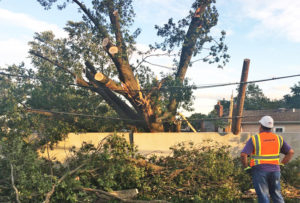New York state has reached a record $72 million settlement with Altice, following the company’s poor performance during last year”™s Tropical Storm Isaias, Gov. Andrew Cuomo has announced.

Altice”™s failure to adequately prepare for and restore broadband and cable television service after the August 2020 storm left more than 400,000 of its customers without service, some for as long as 14 days. Following the power and communication outages caused by the tropical storm, Cuomo directed the Department of Public Service to immediately investigate the utilities’ preparations and response to the storms.
The $72 million settlement is the largest ever in New York State for any company under Public Service Commission jurisdiction for failing to follow procedures related to an emergency response.
As part of the settlement agreement, approved by the Public Service Commission, Altice will be required to develop a more robust storm-response program and enhance communication and coordination with municipal and county governments.
“It is beyond unacceptable to leave hundreds of thousands of customers without the ability to access the Internet, especially during a time when so many people rely on broadband for work and school,” Cuomo said. “This settlement makes it clear that telecommunication companies in New York have an obligation to prepare for severe weather and to develop robust storm-response programs, and if they fail to adequately do that job, we will hold them accountable and force them to change the way they do business.”
An investigative report on the incident received by the commission on Feb. 11 found that Altice had apparently failed to adhere to many significant aspects of its response plan and associated severe weather preparedness plan, which contributed to its inability to timely restore service and effectively communicate to customers experiencing outages.
The apparent violations involved include failure to make sufficient readiness plans and post-storm restoration, poor customer service and communications, and inadequate communication and coordination with government officials and electric utilities.
“The primary task of companies under Commission jurisdiction is to supply safe and adequate service to customers,” said Public Service Commission Chair John Howard. “A key component of that is for the companies to be prepared for a storm and to restore service as safely and as quickly as possible, and we will hold them accountable to do just that.
“With this agreement,” Howard sad, “Altice will ensure that costs to improve its reliability will not result in any increased costs to its customers.”
Under the terms of the settlement agreement, Altice will spend $68.54 million to improve the storm resiliency of its system and make other upgrades, without billing customers for the upgrades, and has provided $3.4 million in credits to New York customers impacted by Tropical Storm Isaias.
The investments required by Altice include $4.6 million toward a new state-of-the-art outage communication platform, the hiring of six additional storm recovery and service coordinators and a new full-time, post-storm remediation coordinator, and upgrades to Altice’s Outage Notification Board.
The company will also spend $63.94 million to improve its planning for and response to future severe weather events. Included within this category are upgrades to Altice’s customer care-related infrastructure, including call center technology and digital programs, certain specified customer care initiatives to facilitate improved customer communications, and additional staffing and investment, including additional technicians and other investments to improve reliability of service in New York.
The settlement agreement requires that the improvements be made within two years.
In addition to the $3.4 million in customer credits and the $68.54 million in action items, Altice has also agreed to undertake a series of programmatic, administrative, and policy “improvements” to its storm-related operations to improve the company’s performance in planning for and recovering from future severe weather events.






















